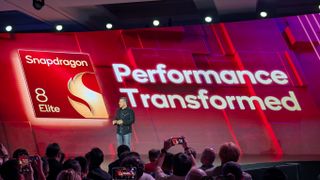Believe the hype: Qualcomm’s Snapdragon 8 Elite will change everything about smartphones
Can you get excited about a microchip? If you’ve never chosen your phone based on the chip inside, that might be worth considering when Snapdragon 8 Elite phones arrive. Qualcomm is doing for the next generation of smartphones what it recently did for Windows laptops, and phones that realize its vision will be unlike anything we’ve seen before.
Last year, Qualcomm launched the Snapdragon X Elite chipset, a powerful processor that uses the kind of low-power cores normally found in smartphones. The obvious benefit is incredible battery life, as mobile processors are made for drinking juice, not swallowing. That advantage is now coming to smartphones, and I expect a big increase in battery life in the next generation. All-day battery life will be the rule, not a rarity.
With the Snapdragon X Elite, Qualcomm has created an incredibly powerful new chipset that includes the Oryon processing core. The X Elite is truly supercharged. The result was the fastest Windows laptops you could buy, and the first Windows laptops in years to outperform a premium MacBook Pro.
This year, Qualcomm Ny Breaking flew to Maui for its Snapdragon Summit and to check out the Snapdragon 8 Elite chipset, which brings the Oryon core to smartphones. After all the speeches and bluster, I had to actually put the chips to work. Qualcomm provided a reference phone for benchmark comparisons – and the results were absolutely mind-blowing.
I’m not normally a benchmark guy, but… wow!
I don’t let benchmark scores influence my ratings – I rely on my real-world testing and experience – but benchmarks can be useful for quick comparison. Take these results with a pinch of salt, but the difference between the Snapdragon 8 Elite and all the other phones I tested is dramatic.
I tested the new Snapdragon 8 Elite alongside a Galaxy S24 Ultra, an iPhone 16 Pro, and even a Google Pixel 9 Pro (for laughs, the Pixel is terrible at benchmarks). Sure, the new Snapdragon beat the older Snapdragon 8 Gen 3 in the Galaxy, but could it beat the iPhone too? The results weren’t even close.
During the 3DMark Wild Life Extreme test, the iPhone scored 4,086, while the Snapdragon scored a whopping 7,019. During the GFX Manhattan 3.1 test, the iPhone managed 3,647 frames, while the Snapdragon produced 7,452 frames, more than twice as many. Again, these are just benchmarks, but the differences are large.

What’s much more interesting is how the Snapdragon 8 Elite compares to laptop chips. Compared to an Intel Core Ultra 7, the Snapdragon 8 Elite beat Intel’s laptop chip in Geekbench in single-core performance, and came very close in multi-core testing.
The Snapdragon 8 Elite beat a laptop chip – what does this mean for the future of phones?
Qualcomm may have created a mobile chipset that performs as well as a PC. I won’t know for sure until I use a final production handset with a Snapdragon 8 Elite in it, like the Asus ROG Phone 9; but for the first time we may see similar power from the best phones and best laptops.
App developers are bringing mobile apps closer in functionality to their desktop counterparts, but we may soon get identical versions of Adobe Lightroom or Microsoft Excel for Android and Windows, not to mention all the games we can finally play on a phone.
I’m very excited about what this means for a concept like Samsung’s DeX. With DeX I connect my phone to a monitor and keyboard and use it as a desktop. If the next Galaxy S25 Ultra packs a Snapdragon 8 Elite, DeX won’t just be a handy way to write long emails and play mobile games on a big screen. With real PC power, my phone could replace the Surface Go laptop I use for work.
Great power comes with a big price tag
The problem is that energy is expensive. Qualcomm is doing everything it can to beat the competition with this latest chip, both in terms of processing performance and power management. Producing the Snapdragon 8 Elite will be more expensive than producing previous chips, and rumors suggest it will cost a lot more than the last generation, for the phone makers that buy it.
If it costs Samsung or OnePlus $40 (US estimate) more per chip, I’d expect this to amount to a $100 / £100 / AU$200 price increase for the phone. The prices of many of the top Android phones have risen this year, and that trend is likely to continue.
Would I pay $1,400 / £1,350 / AU$2,400 for a Galaxy S25 Ultra? Maybe, if the Ultra can really replace a laptop computer.

I’m not sure if a phone/laptop hybrid will appeal to most people, but I can imagine companies deciding to buy one device instead of giving their employees a phone and a laptop. If we see some good accessories that make it easy to use Snapdragon 8 Elite phones as a PC replacement, I think phone makers will start selling devices with that purpose front and center.
Everything about your smartphone will be better with such a fast chip in it, from surfing the Internet to playing games and getting things done. Your network connection will seem faster as the phone can process the data faster and load pages much faster than before.
Honestly, we don’t even know what the future will bring if phones are this powerful because our imaginations have limited this power to big, heavy machines with gigantic batteries and an attached keyboard. I hope to see entirely new categories of games and new app concepts that will make yesterday’s phone seem primitive. I’ll also be happy if I can rely on my next phone to last all day like my laptop.
